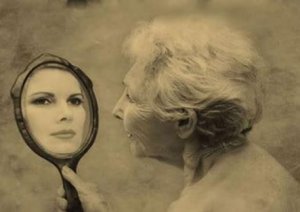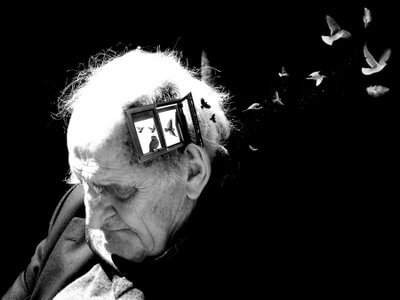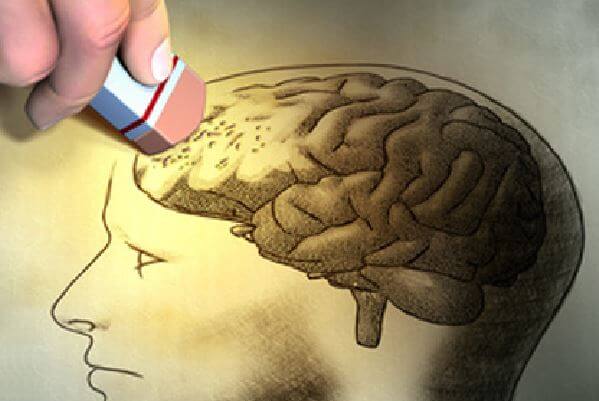Dementia Has Many Faces

Dementia has many faces, many ways of teaching us just how horrible oblivion is. Traditionally the most well-known dementia is Alzheimer-type dementia, but it’s not the only one out there. Yet, it is the most common.
Contrary to common belief, not all types of dementia are irreversible. In some cases, if the cause is determined, it can be treated and even corrected. Some cases include: dementia due to B12 deficiency, caused by vasculitis, hypothyroidism or hydrocephalus, among others.
Currently, all the types of dementia are included in the DSM-5 within Neurocognitive Disorders. They are classified along with Delirium, Amnestic Disorders and other Neurocognitive Disorders. These disorders are those in which the cognition loss or affectation hasn’t been present since birth or early childhood. Therefore, there is a decline, visible if we compare the current level of performance with a previous one.

Alzheimer-type Dementia
It consists of a degenerative cerebral disease whose causes are unknown. Its onset tends to be gradual, and it implies a continuous, slow and progressive deterioration. This dementia usually has an average duration of 8-10 years. Currently, this disease has no cure. Three phases can be distinguished:
The initial phase (approximately 2-4 years):
It’s beginning is usually sudden, and the main characteristic is a deterioration in recent memory. This is the part of the memory which refers to what is happening in the present moment. That is to say, they will have difficulties remembering daily tasks and learning.
In regards to language, it’s common for the individual to lose the richness of their vocabulary. Because they will find it difficult to find the words (anomia) which they then try to solve by using circumlocutions (talking around the subject) and paraphrasing. Paraphrasing consists in the substitution of one word for another in a similar context.
Also, changes in personality can occur, such as apathy (which is overall laziness or lack of interest), irritability, aggression, rigidity, etc. Rigidity is understood as the inability to think flexibly. That is to say, they obsess with an idea. No matter how much you reason with them, the idea doesn’t change.
There may also be some affective changes, such as anxiety or depression. Because at times they’re aware of the beginning of the disease, specially because they notice their own memory problems. In these cases, the individuals and their family members have to adapt to a new way of life. And this is a challenge that encompasses stress and a lot of pain.

Second phase (approximately 3-5 years):
The intellectual deterioration continues, with the appearance of the aphasic-apraxic-agnostic syndrome. This results in frequent forgetfulness, difficulty in the realization of simple tasks such as getting dressed or washing up and difficulty recognizing family members and objects. This syndrome makes supervision necessary.
Retrograde amnesia also appears. That is to say, the inability to remember events from the past. These individuals tend to try to conceal this by confabulating. This consists in making up events that haven’t happened in order to fill in the blank spaces of their memory. Yet, the individuals do it without the intention of lying.
Their judgment deteriorates. They become more impulsive and no longer distinguish right from wrong, nor what kind of behavior is acceptable in private or in public, etc. Their capacity for abstract thinking also deteriorates, which produces an loss of ability in problem solving and task planning.
The rest of the symptomatology worsens and psychotic symptoms may arise. Hallucinations, for example, such as saying that they have spent time with their mother when she has been dead for many years. Or delusions, such as saying that things are being stolen from them, when they are actually just losing or misplacing them.
In this phase, they no longer know how to orient themselves in time (hour, day, month or the year they are in), nor in space (where they live, different rooms of the house, etc). A person who suffers from Alzheimer-type dementia, at this point, is incapable of surviving without supervision. They require supervision, even if they’re able to perform basic daily tasks by themselves.
Third phase (variable duration):
During this phase, the individual doesn’t recognize themselves in the mirror, because they think they are younger than the person the see in the reflection. They also doesn’t recognize the closest people in their lives. Their language becomes progressively slower, gradually becoming mute.
Severe alterations in their gait occur. For example, a gait with very short steps and shuffling or dragging of the feet is most characteristic. This can possibly give way to stumbles and falls, resulting in apraxia of gait (the inability to walk because they have forgotten how to do so). In this phase, the patient will require help to perform basically every activity. It usually ends in bed rest.

Dementia with Lewy bodies
Dementia with Lewy bodies is one of the most difficult types to distinguish, besides being one of the latest to be discovered. This is so because it has some shared symptoms with Alzheimer-type dementia and Parkinson’s dementia. Thus, it tends to be confused with either of these. It is currently considered the second most common type.
Therefore, its symptoms are mainly the following:
- Aphasic-apraxic-agnostic syndrome: it is characteristic of Alzheimer-type dementia, which consists in frequent forgetfulness, difficulty in performing simple tasks and difficulty recognizing family members or objects. In this case, it is characterized by pronounced variations in attention and alertness.
- Recurrent complex visual hallucinations: as well as auditory hallucinations and delusions. Symptoms associated with disorders of REM sleep behavior are very common (which can be a very early manifestation), in addition to hallucinations of other types of sensory modalities, depression and delusions.
- Parkinsonian symptoms: like in Parkinson’s disease, which includes tremors and rigidity of the extremities.
Spontaneous Pakinsonian symptoms should begin after the beginning of the cognitive decline. The greater neurocognitive defects will appear at least a year before the motor symptoms. It should also be distinguished from the extra-pyramidal symptoms produced by neuroleptics. These are motor symptoms due to the medication used to treat the hallucinations and delusions. Up to 50% of the individuals with NCD with Lewy bodies have a significant sensibility to these drugs.
Often they suffer repeated falls and syncopations, which are temporary losses of consciousness. These are accompanied by a momentary paralysis of the heart‘s movements and breathing. This is due to a lack of blood flow to the brain, as well as unexplained transitory episodes of losses of consciousness.
Vascular Dementia
Vascular dementia is caused by a series of small strokes over an extended period of time. These vascular strokes are blockages or interruptions in the blood flow to a certain part of the brain. This produces the neuronal death of the affected area.
Thus, it is characterized by a deterioration in steps whose symptoms are difficult to predict, since they depend on the cerebral area which was affected. Even so, in its early stages, it is characterized by frequent forgetfulness and problems in orientation. Also, personality changes or difficulty speaking may occur.

Parkinson’s Dementia
This type of dementia, Parkinson’s dementia, has to be distinguished from Parkinson’s disease. Parkinson’s disease is characterized by tremors in the hands, arms, legs, jaw and face, rigidity in the arms, legs and torso, sluggishness of movements and balance and coordination problems.
This type of dementia is characterized by the typical tremors of Parkinson’s disease along with the cognitive slowing of the superior functions and very important emotional alterations. It is typical to find a severe depressive state in these patients.
It differs from the other types in that the aphasic-apraxic-agnostic syndrome doesn’t appear, such as it does in Alzheimer’s. Also, in that the hallucinations and delusions are not as prominent or common as in Dementia with Lewy bodies. Highlighting, however, the cognitive sluggishness and the body tremors.
In this article, we have described the most common types of irreversible dementia. But, other types of dementia exist, such as the frontotemporal kinds- Pick’s dementia being the most common-, Huntington’s disease, dementia associated to HIV, dementia caused by prions, among others.
This text is provided for informational purposes only and does not replace consultation with a professional. If in doubt, consult your specialist.








